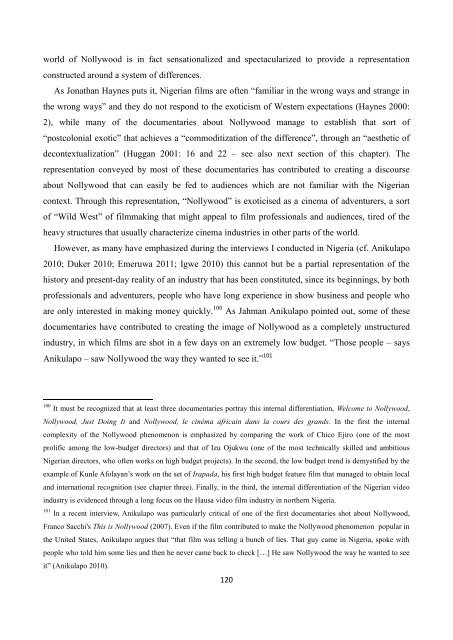You also want an ePaper? Increase the reach of your titles
YUMPU automatically turns print PDFs into web optimized ePapers that Google loves.
world of Nollywood is in fact sensationalized and spectacularized to provide a representationconstructed around a system of differences.As Jonathan Haynes puts it, Nigerian films are often “familiar in the wrong ways and strange inthe wrong ways” and they do not respond to the exoticism of Western expectations (Haynes 2000:2), while many of the documentaries about Nollywood manage to establish that sort of“postcolonial exotic” that achieves a “commoditization of the difference”, through an “aesthetic ofdecontextualization” (Huggan 2001: 16 and 22 – see also next section of this chapter). Therepresentation conveyed by most of these documentaries has contributed to creating a discourseabout Nollywood that can easily be fed to audiences which are not familiar with the Nigeriancontext. Through this representation, “Nollywood” is exoticised as a cinema of adventurers, a sortof “Wild West” of filmmaking that might appeal to film professionals and audiences, tired of theheavy structures that usually characterize cinema industries in other parts of the world.However, as many have emphasized during the interviews I conducted in Nigeria (cf. Anikulapo2010; Duker 2010; Emeruwa 2011; Igwe 2010) this cannot but be a partial representation of thehistory and present-day reality of an industry that has been constituted, since its beginnings, by bothprofessionals and adventurers, people who have long experience in show business and people whoare only interested in making money quickly. 100 As Jahman Anikulapo pointed out, some of thesedocumentaries have contributed to creating the image of Nollywood as a completely unstructuredindustry, in which films are shot in a few days on an extremely low budget. “Those people – saysAnikulapo – saw Nollywood the way they wanted to see it.” 101100 It must be recognized that at least three documentaries portray this internal differentiation, Welcome to Nollywood,Nollywood, Just Doing It and Nollywood, le cinéma africain dans la cours des grands. In the first the internalcomplexity of the Nollywood phenomenon is emphasized by comparing the work of Chico Ejiro (one of the mostprolific among the low-budget directors) and that of Izu Ojukwu (one of the most technically skilled and ambitiousNigerian directors, who often works on high budget projects). In the second, the low budget trend is demystified by theexample of Kunle Afolayan’s work on the set of Irapada, his first high budget feature film that managed to obtain localand international recognition (see chapter three). Finally, in the third, the internal differentiation of the Nigerian videoindustry is evidenced through a long focus on the Hausa video film industry in northern Nigeria.101 In a recent interview, Anikulapo was particularly critical of one of the first documentaries shot about Nollywood,Franco Sacchi's This is Nollywood (2007). Even if the film contributed to make the Nollywood phenomenon popular inthe United States, Anikulapo argues that “that film was telling a bunch of lies. That guy came in Nigeria, spoke withpeople who told him some lies and then he never came back to check […] He saw Nollywood the way he wanted to seeit” (Anikulapo 2010).120
















